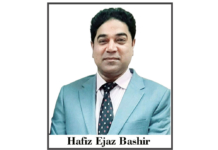In 1947, the population of West Pakistan (territory of modern Pakistan) was 32 million people; while the Census of 2017 shows that this population had increased to 220.8 million people and has become almost 229 million in May 2022. With a population growth rate of near 2.0 percent, we are adding 4.5 million people to our population every year. Thirty percent of this population is children below 18 years of age. Another 30 percent is young between that age of 18 years and 30 years. (This 60 percent of the population is the youth bulge that can be transformed into a viable resource for future economic growth or a burden to the economy if left to its own resources of poverty, illiteracy and unskillfulness). Thirty percent of the population is between the age 30 to 65 years or the adult working population. Ten percent is above 65 years of age, and should be enjoying a healthy retired life, but most of them are still working because of lack of income and social security facilities in the country.
Poverty and deprivation also force many children between 15 years and 18 years to work menial jobs of different kinds all over the country. Children below 15 years have also been seen working at brick kilns and as domestic servants in houses of elite families. Employing these children is an illegal activity but exists blatantly under the very eyes and noses of the law enforcers, the government agencies and child right organizations etc. According to the Economic Survey of Pakistan in 2020-2021, the total enrolment in the country in primary classes was 24.6 million children, out of which 11.1 million (45.1%) were girls. The enrolment in middle classes came down to just 8.0 million, out of which 3.6 million (45.0%) were girls or a drop out of 16.6 million children (out of which 7.5 million were girls). The total enrolment in high school came down to 4.2 million, out of which 1.9 million (45.2%) were girls, or another 3.2 million children (out of which 1.7 million were girls) did not reach high school.
The enrolment in high secondary-inter classes was just 1.8 million, out of which 0.8 million (44.4%) were girls (on average 45% of all enrolments at all levels were girls). This data shows that out of 24.6 million children enrolled at primary levels only 1.8 million were able to pass high school and get admission in intermediate levels, while a staggering 22.8 million children (45% of which were girls dropped out of the system of formal schooling and never passed their metric exam). (I have still not discussed the level of textbooks, teachers and other problems in our public schools in this article). How do the policymakers expect to promote economic growth in the country when the education system is not ready to part minimum level of skills to its children at any level? Unskilled and uneducated children would not produce skilled labor force in the future; therefore, the productivity of this youth bulge would be near zero and that in turn would mean very low employment levels and therefore low-income levels of those that are employed.
Total labor force in the country was 50.1 million in 2021, that means that out of an adult population of 135 million (excluding 30% children and another 10% old age population) only 50 million are part of the labor force would give us 85 million adults that are not part of the labor force in Pakistan and are either homebased workers or are staying at home as house wives (70 million women and 15 million men).
According to World Bank data, unemployment rate in the country is 4.7%, therefore 2.3 million people out of 50.1 million labor force are unemployed in Pakistan which is a very high number from proportion of population in other parts of the world, but in context of Pakistan is considered natural rate of unemployment or permissible unemployment at full employment. Pakistan’s economy has grown by six percent in the past year, which is a healthy growth rate for any country with unskilled and uneducated population and labor force. GDP has increased to 330 billion dollars.
Unfortunately, the fruits of this impressive GDP growth are not reaching a vast part of the population, especially those that earn less than rupees 1000 a day or Rs 30,000 a month with inflation levels reaching 12.2 percent. It is important to point here that if we do not give productive, skill-based education to our children and do not make the bulk of our labor force productive with international work habits, the economic future of the country becomes bleaker, especially when 58 percent of GDP comes from services sector and only 42% of GDP is contributed by agriculture (22%) and industrial sector (20%). This future becomes even bleaker when all these sectors and their sub sectors are becoming mechanized and the industry is moving towards robotics that would only employ highly skilled, specialized and educated labor in the future.
Therefore, it is a moment of serious thought for the policy managers and employers in Pakistan that there would be an increased skill gap between the supply and demand of the labor force in all three sectors of the economy if the children of today are not educated in skills, productivity, know-how, international work habits of tomorrow, as well as to teach them to work and adapt with the fast-changing market and technological conditions the poverty gap between the skilled as educated few (most of which leave the country as brain drain) and the unskilled and poverty stricken majority further dividing the country into haves and have-nots.







